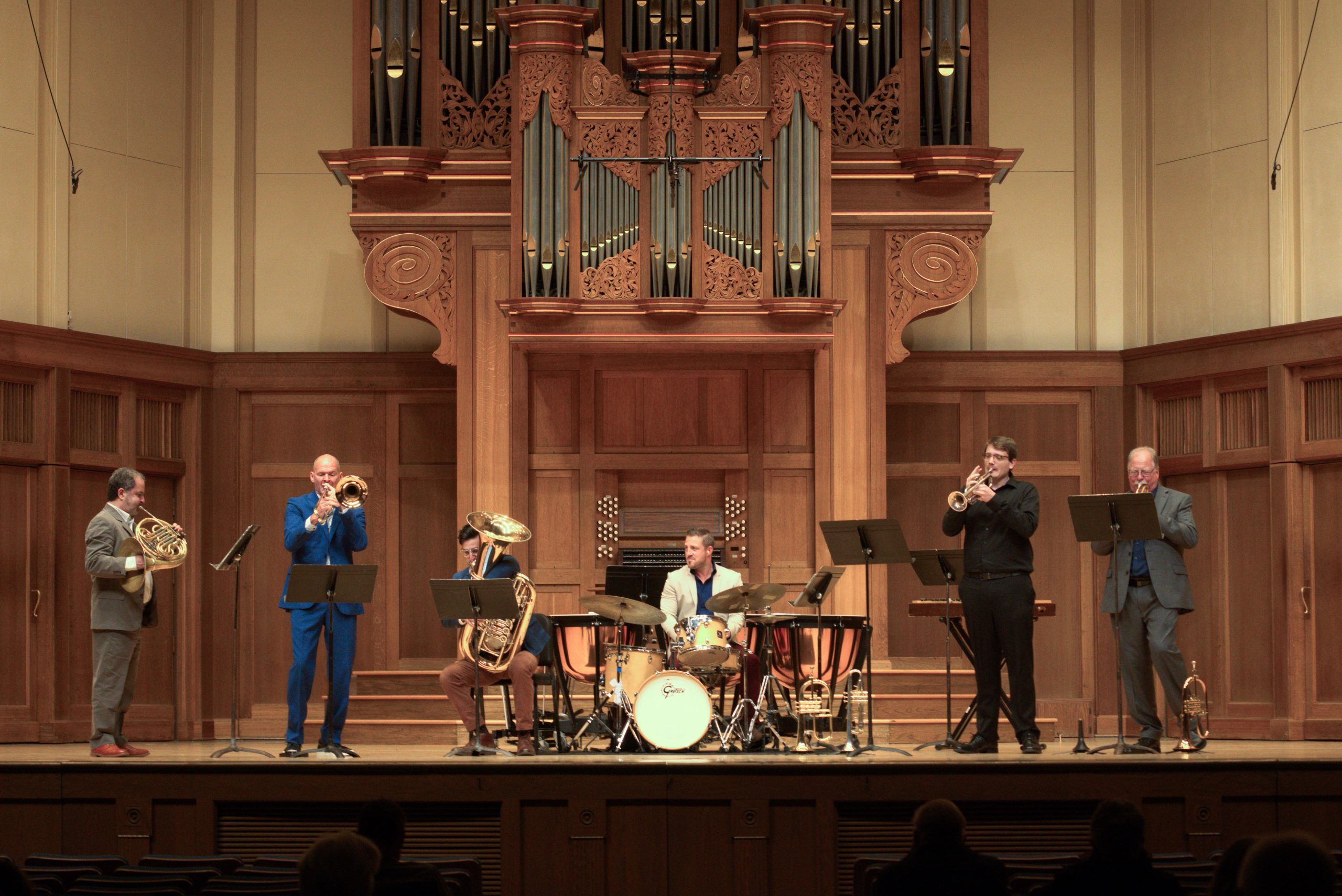Lawrence University has a long tradition of inviting guest ensembles from around the country to perform in Memorial Chapel. This past Wednesday, Sept 28 we were offered something rarer when the visiting Wisconsin Brass Quintet was joined by the Lawrence Brass faculty for a combined program. The first half featured ever-popular film music, while the second half included Cuban dances, a tune by Björk, French Romanticism and Russian modernism.
The Wisconsin Brass Quintet began first, consisting of trumpeters John Aley and Oliver Smith, horn player Daniel Grabois, trombonist Mark Hetzler, tubist Tom Curry and drummer Matthew Endres. They opened with Justin Hurwitz’s “Another Day of Sun” from the 2016 hit musical-film “La La Land”. As the film’s opening song, the choice was particularly fitting, while the group’s energetic performance properly matched its demeanor.
Two excerpts from scores by Leonard Bernstein followed, “Presto Barbaro” from “On the Waterfront” and three numbers from “West Side Story.” The first of these began with a terrific drum solo from Endres, which was no surprise to his colleagues, each of whom stepped to the side beforehand. Drum solos have a bad reputation—they are often accused of randomness or brashness and are difficult to pull off otherwise. Endres’ solo did not fit such stereotypes, being a firm product of both virtuosity and artistry.
The “West Side Story” medley was equally engaging, particularly the start of “Something’s Coming” where ensemble-wide blending created an effectively mysterious atmosphere. A lyrical rendition of “Maria” was next, and afterwards “America,” which featured a trombone solo of incredibly distinct character and expression. The trumpet duets of the latter song, however, were a faithful execution, but offered little interpretative attempt.
The Wisconsin Brass Quintet continued with an excerpt from “Cinema Paradiso” by both Ennio Morricone and his son Andrea Morricone. A substantial contrast to the preceding song, the work demonstrated the often-overlooked expressive potential of the brass family. The trumpet solos from Aley were particularly striking and matched in quality by Hetzler’s imposing trombone solos, sometimes in the instrument’s highest register. The following performance of Michael Giacchino’s theme from “The Incredibles” bursted full of excitement, though the lackluster build up at the end did not seem to do the work justice.
At this point, the Lawrence Brass faculty took the stage, including both John Daniel and Jessica Jensen (who was subbing for Jeffrey Stannard) on the trumpet, Ann Ellsworth on the horn, Tim Albright on the trombone and Marty Erickson on the tuba. The group presented a set entitled simply “Four Pieces” by the Cuban composer Paquito D’Rivera. The first two movements— “Wapango” and “Danzón” (“Dance”)—were played in a laid-back manner, though it was difficult to tell if this was intentional, or simply lacking in energy. The third, “El Cura” (“The Priest”) offered more excitement, though there was some irony in it appearing more dance-like than the previous movement, “Dance.” The final “Sofia” movement was a masterclass in control and priciness, with its intricate lines played excellently throughout.
Both ensembles combined for the next three works, which began with “Overture” by Bjork. With the combined forces of four trumpets, two horns, two trombones, two tubas and timpani, the group’s sound morphed into a brass chorale of high-quality. There was something remarkable about the larger ensemble’s sound; the musicians seemed to be both more individually comfortable and more cohesive as a whole group.
The choice of “La Delaissado” (“The abandoned girl”) by Joseph Canteloube was a rewarding decision. It is arranged from Canteloube’s art song, where a young girl is heartbroken by unrequited love. The group, who was joined by David Pickar on the glockenspiel, further affirmed the enormous emotive ability of brass instruments, evoking a vast soundscape of sentiment.
For their final work, the combined ensemble performed Dmitri Shostakovich’s “Concertino,” op. 94. In typical Shostakovichian fashion, the composition presented considerable ambiguity as to its general character. Elements of dances, marches and chorales were present, though none seemed all-encompassing. The ensemble matched this stylistic diversity with its own willingness to rapidly alternate timbres and affects.
With an unorthodox combination of guest artists and Lawrence professors, the performance included a remarkable synergy and cohesion throughout. Future couplings between guest ensembles and faculty seem to be a most welcome prospect.


